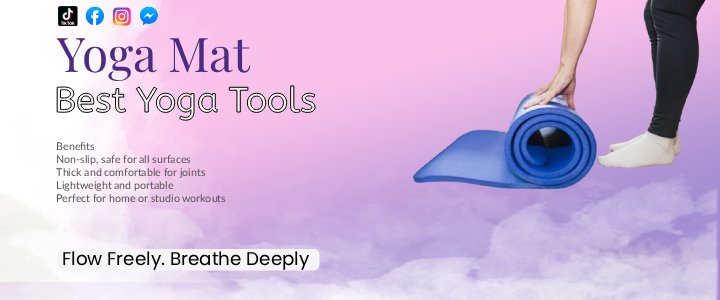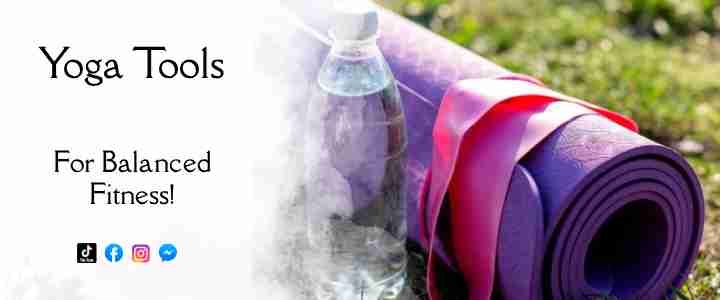Yoga Mat Matters
When people start a fitness or diet program, the first thoughts usually go to meal plans, cardio machines, or weight training. Yet, there’s a subtle but powerful tool that often gets overlooked: the yoga mat. Far from being just a thin piece of foam, a yoga mat is the foundation of many strength and mobility practices. It helps transform living rooms into workout spaces and keeps motivation alive when discipline starts to fade.
In this article, we’ll explore why a yoga mat is more than just an accessory, how it fits into the category of the best yoga tools, and how it can blend seamlessly with other strength and mobility gear to create a complete, balanced routine.
The Struggles We Face When Starting a Program
Starting a new lifestyle is exciting—but it also comes with challenges. Many beginners complain about:
- Lack of space at home to exercise comfortably.
- Slippery floors or uneven surfaces that make stretching or planking difficult.
- Low motivation when workouts feel complicated or uncomfortable.
- Body aches from poor posture or lack of support during exercise.
These issues may seem small at first, but over time they become barriers that make people skip workouts. This is where the right yoga accessories for home, especially a supportive mat, come in as a game changer.
Your yoga mat might be the base of your practice, but props like yoga blocks and straps can elevate it to a whole new level. They help you achieve better posture, flexibility, and support, especially when exploring more advanced poses.
The Hidden Benefits of a Simple Yoga Mat
A yoga mat does more than provide a soft surface. It changes the way the body and mind respond to exercise:
- Consistency Through Comfort
A dedicated mat creates a psychological boundary: when you unroll it, your brain knows it’s time to move. That little ritual can spark consistency, even on low-energy days. - Support for Strength and Mobility
With the right thickness and grip, the mat helps stabilize your joints during lunges, push-ups, or balance poses. It’s not just for yoga—it’s a piece of strength and mobility gear that protects your body. - Encouragement to Explore More
Many users find that once they own a mat, they naturally branch into new routines like Pilates, stretching sessions, or even meditation. It opens the door to a more holistic approach to fitness.
How One Small Change Sparked Big Results?
Take Sarah, for example. She started her fitness journey with strict dieting and high-intensity workouts but quickly felt burned out. “I was tired of forcing myself to the gym,” she recalls. Then she bought a yoga mat for her tiny apartment. At first, she only used it for short evening stretches. But soon, those 10 minutes turned into 30, blending bodyweight exercises, yoga flows, and meditation.
Within months, she not only lost weight but also felt more energized and less stressed. The mat wasn’t a miracle product—it simply gave her the foundation to stay consistent, making every workout easier and more enjoyable.
Tips to Mix and Match Your Fitness Gear
Your yoga mat works best when paired with the right tools. Here are some ideas:
- Resistance Bands: Use them for squats and rows directly on your mat. The grip keeps you steady, while bands build strength.
- Foam Roller: After intense sessions, roll out tight muscles on the mat for recovery.
- Jump Rope: Start your workout with a few minutes of cardio, then step right into yoga or core exercises without leaving your mat.
- Light Dumbbells: Combine strength training with yoga flows for a hybrid session that builds endurance and flexibility.
Think of your mat as the stage. Every other piece of equipment whether it’s bands, weights, or ropes—is part of the performance.
Making It Personal
The beauty of yoga mats is how personal they can become. Some prefer ultra-thick mats for joint comfort, while others love lightweight travel versions. The key is to choose one that feels inviting enough that you look forward to rolling it out daily.
If your goal is weight loss, pair it with short HIIT circuits or fat-burning yoga flows. If your focus is stress management, use it for deep breathing and long stretches. Whatever the program, the mat adapts to your journey.
A yoga mat helps build focus and balance, but if you’re looking to add a dynamic cardio element to your routine, try picking up a jump rope workout. It’s a simple yet powerful way to burn calories, improve coordination, and complement your yoga sessions perfectly.
Fitness and diet success doesn’t always come from the most expensive gear or the hardest routines. Sometimes, it starts with something as humble as a yoga mat. As one of the best yoga tools, it’s the piece that supports strength, flexibility, and mindfulness—all from the comfort of home.
So, next time you’re building your collection of yoga accessories for home, remember that your mat isn’t just an accessory—it’s the ground beneath your progress.



